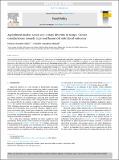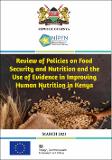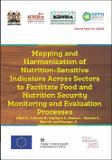| dc.description.abstract | Food and nutrition security is a major global concern. Kenya’s increasing population exacerbates food insecurity, which is at moderate to severe levels. Despite the various policies that the government has put in place to address food and nutrition security, prevalence of food insecurity and malnutrition persists across the country. The study examines the four pillars of food security and their influence on nutrition in the 47 counties. The food security index was calculated across various counties in the country, considering four distinct pillars each with its set of indicators. These pillars encompassed food availability, accessibility, utilization, and stability. The purpose was to construct the food security index based on the pillars in the county governments and assess its role in nutrition indicator (stunting) of different counties. The average food security index score for the 47 counties was 0.48 and ranged between 0.30 and 0.60. Food security reveals significant disparities in food availability, accessibility, utilization, and stability among the counties. The highest food availability index score was 0.57, while the lowest was 0.32, indicating a considerable range in food availability across the counties. Only 15 counties had a food availability index of 0.50 or above, highlighting that many counties still face challenges in ensuring availability of sufficient food. More importantly, food accessibility and food utilization scored 0.86 and 0.94, respectively, indicating they are critical to overall food security. Noteworthy, while food might be available, its accessibility and proper utilization are crucial in achieving food security. The average food stability index score was 0.41, and it ranged between 0.19 and 0.62, indicating instability in continuous supply of food resources across the counties. Additionally, stunting prevalence among children varies widely from 9 per cent to 37 per cent. This reflects the uneven impact of food security on child nutrition across the different counties. The key policy recommendations focus on strengthening the four pillars to enhance food security comprehensively. | en |
| ppr.contributor.author | Peter Kipkorir, Hillary Wakhungu, Jecinta Ali, Eunice Mulango, Gideon Nyakundi, Isabella Kiplagat, Mary Njeri, Juma Wachilonga, Eric Macharia | en |




